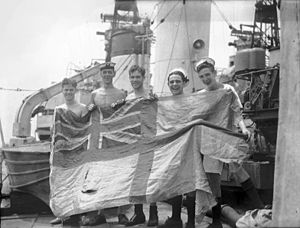Battle of Ushant (1944)
| Battle of Ushant | |||||||
|---|---|---|---|---|---|---|---|
| Part of Second World War, Invasion of Normandy | |||||||
 Crew members of HMS Tartar display their torn White Ensign |
|||||||
|
|||||||
| Belligerents | |||||||
|
|
|
||||||
| Commanders and leaders | |||||||
|
|
|
||||||
| Strength | |||||||
| 8 destroyers | 3 destroyers, 1 torpedo boat | ||||||
| Casualties and losses | |||||||
| 1 ship damaged | 1 destroyer scuttled 1 destroyer sunk 140 prisoners 39 dead |
||||||
The Battle of Ushant, also known as the Battle of Brittany, occurred on the early morning of 9 June 1944 and was an engagement between German and Allied destroyer flotillas off the coast of Brittany. The action came shortly after the initial Allied landings in Normandy. After a confused engagement during the night the Allies sank one of the German destroyers and forced another ashore, where she was wrecked.
On 6 June 1944, the day of the first landings in Normandy, the remnants of the German 8th destroyer flotilla, consisting of the Type 36A Z24 and Z32, and the ZH1 (formerly the Dutch destroyer Gerard Callenburgh) were ordered by Vizeadmiral Theodor Krancke to sail from the Gironde to Brest. The order was intercepted by the British which detailed Canadian Bristol Beaufighters from RAF Coastal Command to attack the German ships as they sailed through the Bay of Biscay. In the ensuing raid, the destroyer Z32 was slightly damaged. The German ships made port at Brest, where Z24 and Z32 had their anti-aircraft armament increased. They then put to sea again on 8 June in company with the Flottentorpedoboot 1939 class torpedo boat T-24, the sole survivor of the 4th torpedo boat flotilla, bound for Cherbourg under the command of Theodor von Bechtolsheim, where they would reinforce German positions.
...
Wikipedia
